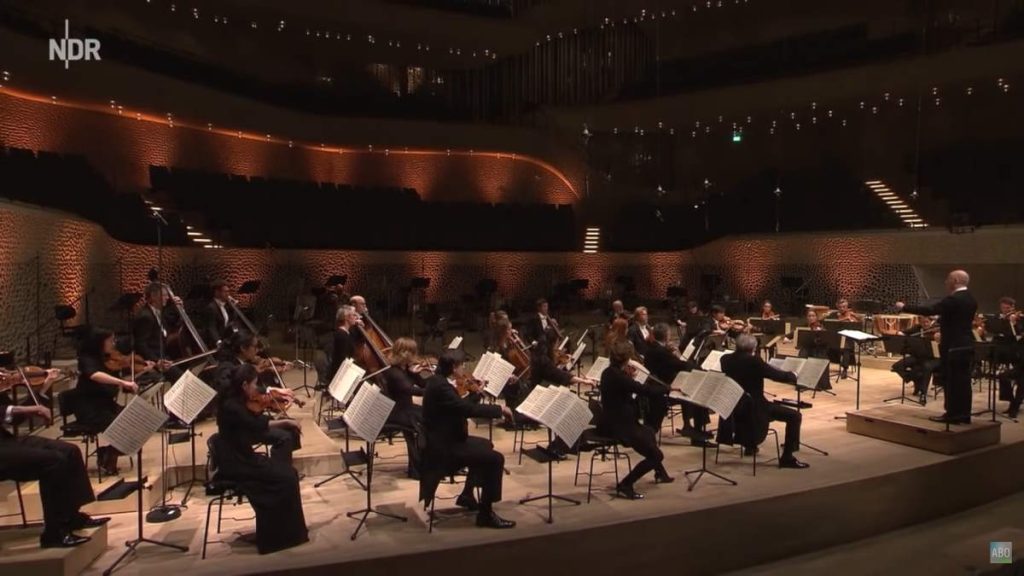The Kammerorchester Basel (Basel Chamber Orchestra) performs Pyotr Ilyich Tchaikovsky’s Serenade for Strings in C major, Op. 48 at the Grote Zaal concert hall, Amsterdam on May 18, 2014.
Pyotr Ilyich Tchaikovsky’s Serenade for Strings
Composed in 1880, the Serenade for Strings was given a private performance at the Moscow Conservatory on 3 December 1880. Its first public performance was in St Petersburg on 30 October 1881 under Eduard Napravnik (24 August 1839 – 10 November 1916), the Czech conductor and composer, who settled in Russia and is best known for his leading role in Russian musical life as the principal conductor of the Imperial Mariinsky Theatre in Saint Petersburg for many decades.
Movements
Serenade for Strings has 4 movements:
- Pezzo in forma di sonatina: Andante non troppo – Allegro moderato
- Valse: Moderato – Tempo di valse
- Élégie: Larghetto elegiaco
- Finale (Tema russo): Andante – Allegro con spirit
1. Pezzo in forma di sonatina
The first movement is marked Pezzo in forma di sonatina (Piece in the form of a little sonata) and is in sonata form. Tchaikovsky intended the first movement of the Serenade for Strings to be an imitation of Mozart’s style, and it was based on the form of the classical sonatina, with a slow introduction. The stirring 36-bar Andante introduction is marked “sempre marcatissimo” and littered with double-stopping in the violins and violas, forming towering chordal structures. This introduction is restated at the end of the movement, and then reappears, transformed, in the coda of the fourth movement, tying the entire work together.
On the second page of the score, Tchaikovsky wrote, “The larger number of players in the string orchestra, the more this shall be in accordance with the author’s wishes.”
2. Valse
The second movement, Valse, has become a popular piece in its own right. At its premiere, the movement had to be repeated. Anton Rubinstein (November 28 [O.S. November 16] 1829 – November 20 [O.S. November 8] 1894), the Russian pianist, composer and conductor, and Tchaikovsky’s former teacher declared that the second movement is Tchaikovsky’s best piece. Considering the dance origins of the minuet and trio, and its usurpation by the abstract instrumental genres of the 18th century, it seems sensible that Tchaikovsky would integrate the most amorous of 19th-century dances into his symphonies and the String Serenade.
3. Élégie
The third movement, Elegia, opens with another chorale-like passage, here, one that incessantly aspires to rise above its mezza-voce tessitura. The tender melodic writing of the first theme is brought to fruition upon its return, elaborated with another, more florid melodic layer; the transparent soaring counterpoint floats above the lightest of accompaniments, arpeggiated pizzicato figures in the low strings. The darker, more desperate voice found in the composer’s last three symphonies dominates much of the mood of this movement.
4. Finale (Tema russo)
The finale (Tema russo) of Tchaikovsky’s Serenade for Strings opens with an introduction in the dominant key (G), bringing us back one step closer to earth, smoothly linking the D-major Elegia and the C-major Finale. The Andante introduction is based on a Russian folk tune, a Volga “hauling song”. Both the main theme of the Allegro con spirito, based on the shape of the Serenade’s opening chorale, and that chorale itself, which is the movement’s penultimate gesture, provide an arching sense of unity that spans the entire work.
The chamber orchestra Kammerorchester Basel (also: kammerorchesterbasel) was founded in Basel, Switzerland, in 1984. In the tradition of Paul Sacher’s Basler Kammerorchester, its focus is on both early music and contemporary music. Concertmaster and frequently the conductor is Julia Schröder, as of 2013.
Sources
- Serenade for Strings (Tchaikovsky) on Wikipedia
- Kammerorchester Basel on Wikipedia
- Tchaikovsky – Serenade for Strings in C major on ClassicFM
- Serenade for Strings on LaPhil.com



Wunderbar gespielt! Und auch super aufgenommen. Ein Genuss.
Danke fürs zuschauen, Dirk!